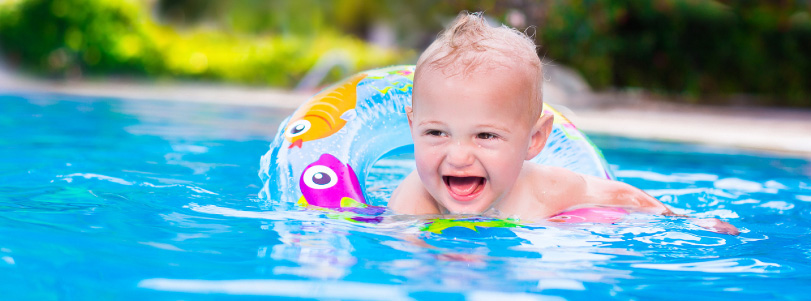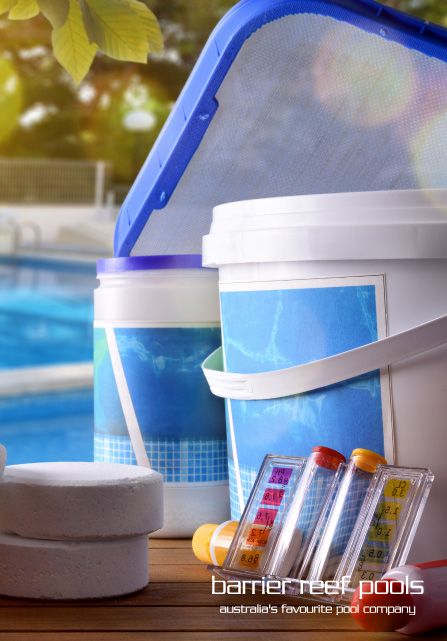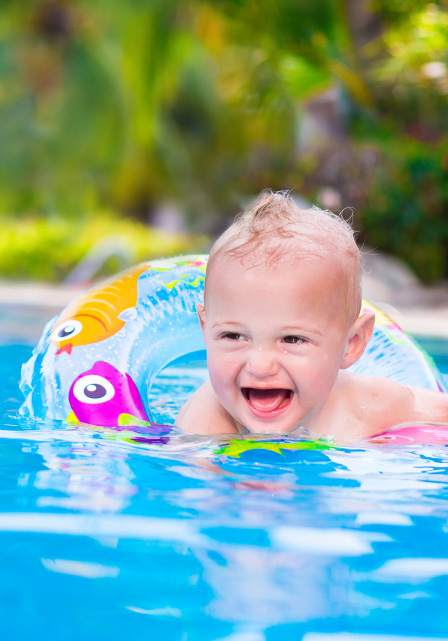The Complete Pool Maintenance Checklist
While having a swimming pool assures wonderful summer days, a lot of work must be done to keep it in working order at all times. Whether you use your swimming pool on a daily basis or perhaps occasionally, routine upkeep is essential. To ensure that you do not overlook any steps, here is a pool maintenance checklist that includes everything you need to have to keep a clean and safe pool on your property.

Pool Maintenance Supplies Checklist
Before you begin, you must have all the supplies necessary to carry out all the tasks. Some things you might need are:
1. Pool Testing Kit
A pool testing kit aids in balancing the levels of pH, calcium, alkalinity, and chlorine in the swimming pool water. A wide range of test kits is available in the market. Pool water analysis kits, calcium hardness test strips, and chlorine indicator strips are among the most common. While strips are a quick and easy way to test, it is also a good idea to have a high-quality test kit with fresh reagents. However, it is recommended to change the test kits every season because the shelf life of the chemical reagents included in the test kits is rather limited.
2. Swimming Pool Chemicals
Numerous chemicals are needed to keep the swimming pool in a functional state. Before you add any of them into the pool, get the pool water tested. Once you have tested the swimming pool water, you will get an understanding of what chemicals need to be added to maintain a safe water balance. Several water balancing supplies are available like pH balancer, alkalinity balance, chlorine, stabiliser, conditioner, calcium balancer, lubricants, and so on. Non-chlorine chemicals are also popular among swimming pool owners. All these supplies help in restoring the water balance to the optimal level.
3. Pool Maintenance Accessories
For regular cleaning, you will need certain pool maintenance accessories that will assist you in keeping your swimming pool sparkling clean. A pool pole, a vacuum hose, a leaf rake, a brush, and a leaf skimmer are the most important tools in this area. These cleaning supplies aid in the removal of dirt, leaves, and other debris that may be floating on the surface of the pool water. In addition, you can vacuum the pool’s bottom and brush the tiles on the sides. A leaf skimmer can help clear up any material that may have fallen into the pool. Because leaves, bugs, and debris are likely to accumulate in the pool on a regular basis, it is prudent to invest in these pool maintenance supplies.
4. Winter Pool Cover
Your swimming pool would remain relatively unused during the winters. To protect your pool from getting unwanted stains and debris, it is best to get a pool cover. It not only keeps the pool clean but also protects the swimming pool from algae growth. It helps in maintaining proper water balance as well. In this way, by blocking debris and sunlight, pool covers safeguard the pool surfaces during the harsh winter season.

5. Toolbox
It is always advisable to keep your toolbox handy to fix any last-minute problems. A wrench and screwdriver are especially useful for tightening drain plugs, ladders, and other such items. Nut drivers and pliers are also common tools.
Pool Maintenance Routine
Once you have equipped yourself with all the necessary supplies, you can begin the swimming pool maintenance routine. Some basic tasks that you need to perform are:
1. Skimming Off Leaves And Debris
Skimming is a part of the daily pool maintenance routine. You can skim off the leaves and debris using a long-handled leaf skimmer. The skimmer collects all the leaves, insects, and other objects that may be floating in the pool water. If the material is not skimmed for an extended period, it sinks to the bottom of the pool, leaving stains that are difficult to remove. Skimming the pool water regularly also keeps the filtration system from becoming clogged.
2. Brushing The Sediment From Pool Walls
Algae and debris may accumulate on the walls of your swimming pool as well as in other areas like slides and ladders. To prevent the growth of algae and remove all the dirt and debris, you must brush the pool walls and other pool fixtures using a brush.
3. Vacuum The Swimming Pool
Once you have skimmed the pool water and brushed the walls, you can vacuum the pool surface to remove any dirt that might have sunk to the bottom. You can either use an automatic vacuum or a manual one depending on your requirements.
4. Cleaning The Skimmer
While a skimmer allows you to keep your swimming pool clean, it is essential to keep the skimmer tidy as well. It must be cleaned at least once a week. When the skimmer is clean, its efficiency in catching trash and leaves improves, saving you time, money, and effort.
5. Checking The Pump
The pump in your swimming pool is one of the most important components of its circulation system, along with the skimmer, pump strainer, and filter. These components are critical to the proper operation of the chemicals and pool water filtration. Hence, you should run your pump long enough every day to ensure that the water is adequately filtered and that every item in the pool circulation system is in good order.

6. Checking The Filter
Filters are needed to screen out dirt, debris, and other particles from swimming pool water. As a variety of filters are available in the market, each must be cleaned and maintained as per the directions of the manufacturer.
7. Testing Pool Water And Adding Chemicals
Depending on use, test the water in your swimming pool regularly and add chemicals as needed to maintain a suitable balance. Pool chemicals serve as sanitisers and disinfectants. These are essential for limiting the growth of germs and algae in pool water. You can even get shock treatments done to cleanse the pool water.
Conclusion
Follow these easy steps, and you will no longer have any trouble maintaining your swimming pool!
While having a swimming pool assures wonderful summer days, a lot of work must be done to keep it in working order at all times. Whether you use your swimming pool on a daily basis or perhaps occasionally, routine upkeep is essential. To ensure that you do not overlook any steps, here is a pool maintenance checklist that includes everything you need to have to keep a clean and safe pool on your property.
The Complete Pool Maintenance Checklist

Pool Maintenance Supplies Checklist
Before you begin, you must have all the supplies necessary to carry out all the tasks. Some things you might need are:
1. Pool Testing Kit
A pool testing kit aids in balancing the levels of pH, calcium, alkalinity, and chlorine in the swimming pool water. A wide range of test kits is available in the market. Pool water analysis kits, calcium hardness test strips, and chlorine indicator strips are among the most common. While strips are a quick and easy way to test, it is also a good idea to have a high-quality test kit with fresh reagents. However, it is recommended to change the test kits every season because the shelf life of the chemical reagents included in the test kits is rather limited.
2. Swimming Pool Chemicals
Numerous chemicals are needed to keep the swimming pool in a functional state. Before you add any of them into the pool, get the pool water tested. Once you have tested the swimming pool water, you will get an understanding of what chemicals need to be added to maintain a safe water balance. Several water balancing supplies are available like pH balancer, alkalinity balance, chlorine, stabiliser, conditioner, calcium balancer, lubricants, and so on. Non-chlorine chemicals are also popular among swimming pool owners. All these supplies help in restoring the water balance to the optimal level.
3. Pool Maintenance Accessories
For regular cleaning, you will need certain pool maintenance accessories that will assist you in keeping your swimming pool sparkling clean. A pool pole, a vacuum hose, a leaf rake, a brush, and a leaf skimmer are the most important tools in this area. These cleaning supplies aid in the removal of dirt, leaves, and other debris that may be floating on the surface of the pool water. In addition, you can vacuum the pool’s bottom and brush the tiles on the sides. A leaf skimmer can help clear up any material that may have fallen into the pool. Because leaves, bugs, and debris are likely to accumulate in the pool on a regular basis, it is prudent to invest in these pool maintenance supplies.
4. Winter Pool Cover
Your swimming pool would remain relatively unused during the winters. To protect your pool from getting unwanted stains and debris, it is best to get a pool cover. It not only keeps the pool clean but also protects the swimming pool from algae growth. It helps in maintaining proper water balance as well. In this way, by blocking debris and sunlight, pool covers safeguard the pool surfaces during the harsh winter season.

5. Toolbox
It is always advisable to keep your toolbox handy to fix any last-minute problems. A wrench and screwdriver are especially useful for tightening drain plugs, ladders, and other such items. Nut drivers and pliers are also common tools.
Pool Maintenance Routine
Once you have equipped yourself with all the necessary supplies, you can begin the swimming pool maintenance routine. Some basic tasks that you need to perform are:
1. Skimming Off Leaves And Debris
Skimming is a part of the daily pool maintenance routine. You can skim off the leaves and debris using a long-handled leaf skimmer. The skimmer collects all the leaves, insects, and other objects that may be floating in the pool water. If the material is not skimmed for an extended period, it sinks to the bottom of the pool, leaving stains that are difficult to remove. Skimming the pool water regularly also keeps the filtration system from becoming clogged.
2. Brushing The Sediment From Pool Walls
Algae and debris may accumulate on the walls of your swimming pool as well as in other areas like slides and ladders. To prevent the growth of algae and remove all the dirt and debris, you must brush the pool walls and other pool fixtures using a brush.
3. Vacuum The Swimming Pool
Once you have skimmed the pool water and brushed the walls, you can vacuum the pool surface to remove any dirt that might have sunk to the bottom. You can either use an automatic vacuum or a manual one depending on your requirements.
4. Cleaning The Skimmer
While a skimmer allows you to keep your swimming pool clean, it is essential to keep the skimmer tidy as well. It must be cleaned at least once a week. When the skimmer is clean, its efficiency in catching trash and leaves improves, saving you time, money, and effort.
5. Checking The Pump
The pump in your swimming pool is one of the most important components of its circulation system, along with the skimmer, pump strainer, and filter. These components are critical to the proper operation of the chemicals and pool water filtration. Hence, you should run your pump long enough every day to ensure that the water is adequately filtered and that every item in the pool circulation system is in good order.

6. Checking The Filter
Filters are needed to screen out dirt, debris, and other particles from swimming pool water. As a variety of filters are available in the market, each must be cleaned and maintained as per the directions of the manufacturer.
7. Testing Pool Water And Adding Chemicals
Depending on use, test the water in your swimming pool regularly and add chemicals as needed to maintain a suitable balance. Pool chemicals serve as sanitisers and disinfectants. These are essential for limiting the growth of germs and algae in pool water. You can even get shock treatments done to cleanse the pool water.
Conclusion
Follow these easy steps, and you will no longer have any trouble maintaining your swimming pool!


